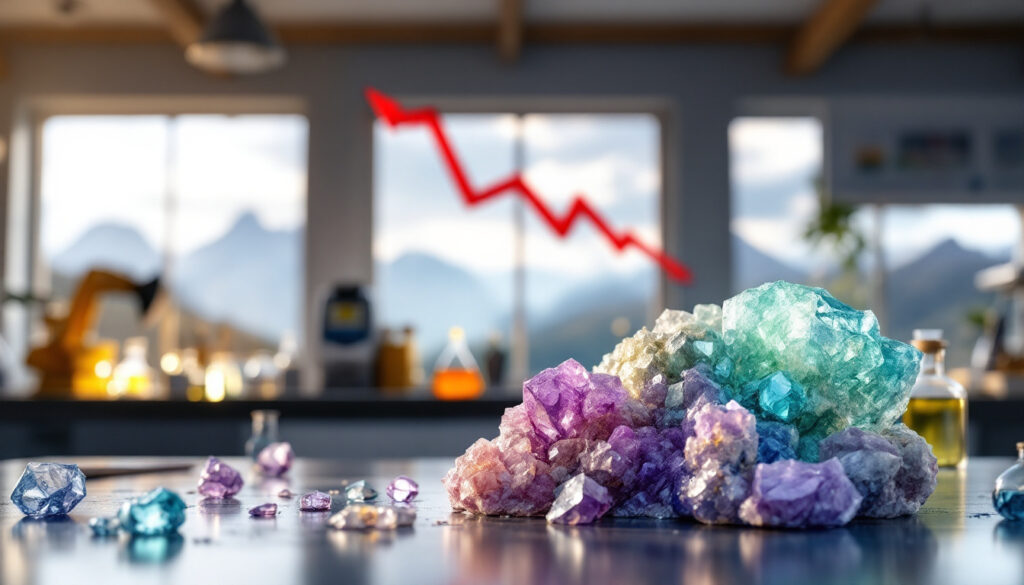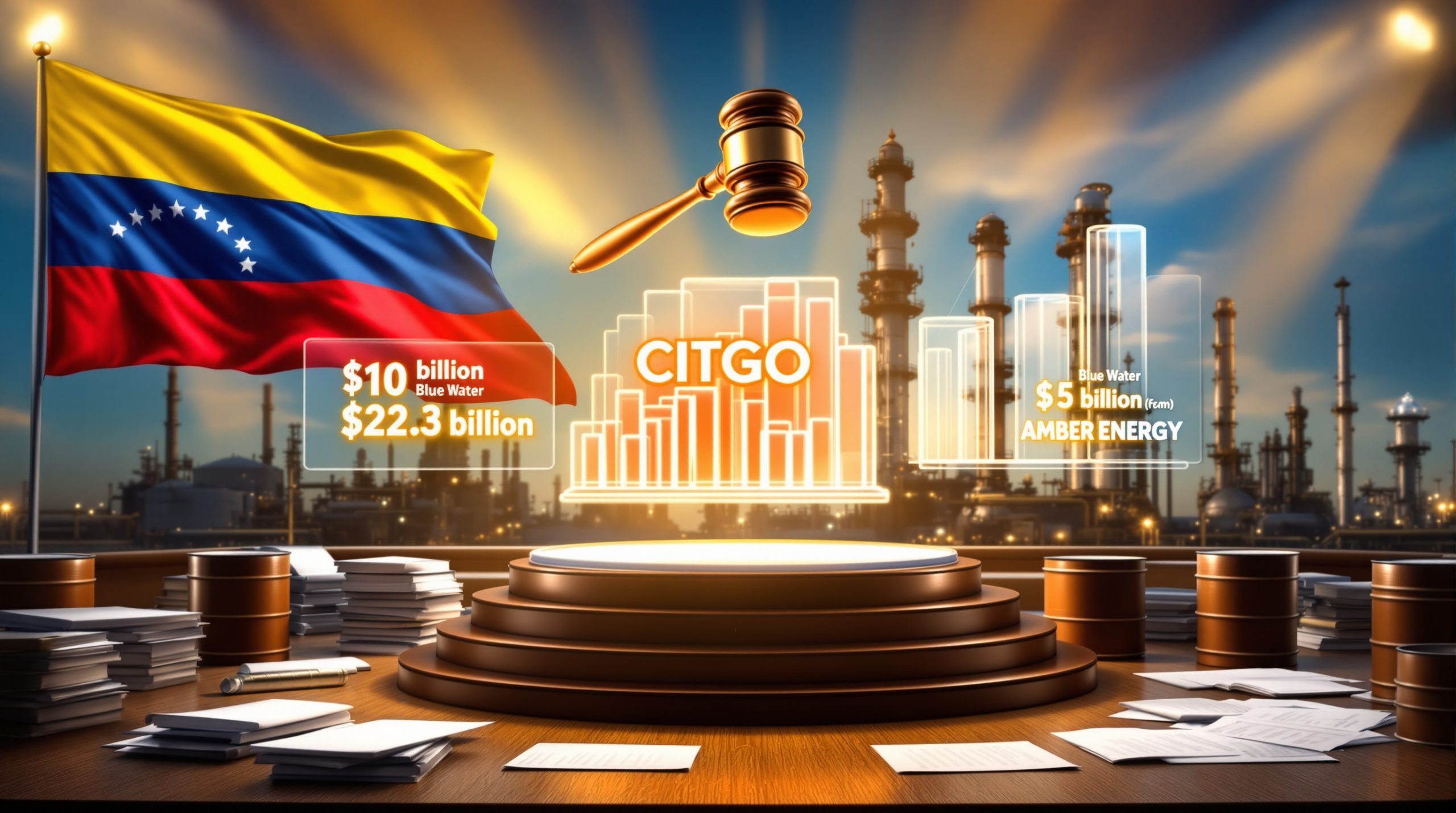What Caused MP Materials' First Quarter Loss in 2025?
MP Materials reported a significant reversal in financial performance for Q1 2025, posting a net loss of $22.6 million ($0.14 per share) compared to the $16.5 million net income achieved in Q1 2024. This stark contrast highlights the challenges faced by America's leading rare earth materials producer as it navigates complex market dynamics and operational transitions.
Key Financial Results Overview
The company's adjusted loss of $0.12 per share matched analyst expectations, providing some reassurance to investors despite the disappointing headline figures. However, the stock still fell 1.3% in after-hours trading following the announcement, reflecting ongoing market concerns about the company's near-term prospects.
Production costs increased substantially by approximately $13.3 million compared to the prior year, representing one of the primary drivers behind the quarterly loss. This surge in costs coincided with a nearly $5 million rise in interest expenses linked to the company's convertible notes due in 2030.
Financial Analyst Perspective: "MP Materials faces the classic manufacturing challenge of scale economics. Their refining facilities require high utilization rates to achieve cost efficiency, but they're caught in a transition period where capacity exceeds immediate demand, creating a significant cost burden."
Production Cost Challenges
The most significant factor contributing to MP Materials' quarterly loss was the substantially lower utilization rates at their refining facilities. Operating high-tech processing equipment at below-optimal capacity creates unfavorable unit economics, as fixed costs are spread across fewer output units.
Management emphasized during their earnings call that increasing the utilization rate of these facilities remains their top operational priority. The company's ongoing mining industry evolution requires these facilities to operate efficiently to achieve long-term competitive positioning.
The rising interest expenses—nearly $5 million higher year-over-year—are primarily attributed to the company's convertible notes due in 2030. This increased debt service burden further pressured quarterly results at a time when operational costs were already elevated.
These combined challenges created a perfect storm of financial pressure despite actual production increases, highlighting the complex balancing act MP Materials faces in its transition to becoming a fully integrated rare earth materials producer.
How Has MP Materials' Production Output Changed?
While financial results disappointed investors, MP Materials achieved notable production milestones that demonstrate ongoing operational progress despite market headwinds.
Rare Earth Concentrate Production
The company produced 12,213 metric tons of rare earth concentrate in Q1 2025, representing a substantial 10% increase compared to the same period in 2024. This production growth reflects continued operational improvements at the Mountain Pass mine in California.
This output growth is particularly noteworthy considering that Mountain Pass remains the only scaled rare earth production site in the Western Hemisphere. The facility's strategic importance extends beyond purely commercial considerations, representing a critical component of secure supply chains for materials essential to defense and clean energy technologies.
The company's ability to maintain and even grow production volumes despite challenging market conditions demonstrates operational resilience and commitment to their long-term strategic vision.
Refined Rare Earth Production
MP Materials achieved its most impressive growth in refined product output, producing 563 metric tons of neodymium and praseodymium (NdPr) at its California refining facility. This represents a remarkable four-fold increase compared to Q1 2024 levels.
NdPr, which refers to neodymium and praseodymium, represents some of the most valuable rare earth elements, essential for manufacturing powerful permanent magnets used in electric vehicles, wind turbines, and various defense applications.
This dramatic growth in refined output demonstrates significant progress in the company's vertical integration strategy, which aims to transform MP Materials from primarily a raw materials producer into a manufacturer of higher-value refined products.
Despite this impressive growth, refining capacity utilization remains below optimal levels. Achieving higher utilization rates will be crucial for improving unit economics and returning to profitability in coming quarters.
What Market Factors Are Affecting MP Materials' Performance?
MP Materials operates within a complex global mining landscape, with pricing dynamics and international trade policies significantly impacting performance.
Pricing Trends in Rare Earth Markets
The company experienced mixed pricing trends across its product portfolio. Realized prices for rare earth concentrates increased 12% year-over-year, providing some tailwind to revenue despite operational challenges.
However, this positive trend was partially offset by a 16% decline in NdPr prices compared to Q1 2024. Since NdPr comprises the higher-value portion of MP Materials' output, this price weakness disproportionately impacted overall financial results.
Price volatility continues to challenge revenue predictability, making financial planning and investment decisions more complex. The rare earth market remains susceptible to rapid shifts based on global supply-demand balances, industrial activity in key consuming sectors like electric vehicles, and policy decisions by major producing nations.
Market dynamics are increasingly shifting due to changes in global supply chains, with growing emphasis on sourcing critical minerals energy security from politically stable jurisdictions. This trend potentially benefits MP Materials over the longer term, though current price pressures reflect ongoing market adjustments.
China Export Strategy Shift
In a strategic move that will significantly impact future quarterly results, MP Materials announced in April 2025 that it would halt rare earth shipments to China. This decision came in direct response to Beijing's implementation of new tariffs on rare earth imports.
"This pivot away from the Chinese market represents both a significant challenge and potential opportunity for MP Materials," notes industry analyst Sarah Chen. "While eliminating a major revenue stream in the short term, it accelerates the necessary transition toward domestic processing and end-market development."
The financial impact of this strategic shift will first appear in the company's Q2 2025 results, as the announcement came after the close of the first quarter. This represents a significant disruption to MP Materials' established revenue streams, requiring substantial business model adaptation.
MP Materials' management frames this challenge as an acceleration of their existing strategy to develop domestic processing capabilities and reduce dependence on Chinese buyers. However, the compressed timeline creates near-term financial pressures that will likely persist through several quarters.
What Is MP Materials' Strategic Position in the Rare Earth Market?
Despite current financial challenges, MP Materials maintains a uniquely valuable position within global rare earth supply chains.
Vertical Integration Progress
The company continues to advance its domestic refining capabilities, with the four-fold increase in refined NdPr production representing tangible evidence of progress. This vertical integration strategy aims to transform MP Materials from primarily a miner and concentrate producer into a manufacturer of higher-value refined materials.
This strategy directly addresses the longstanding challenge within Western rare earth supply chains: despite having mining capabilities, nearly all separation and processing of these materials has historically occurred in China. By developing domestic refining capacity, MP Materials aims to reduce this critical dependency.
Significant challenges remain in achieving cost-effective full-scale refining operations. The technical complexity of rare earth separation processes, combined with the substantial capital investments required and the learning curve associated with scaling new facilities, creates temporary inefficiencies that impact financial performance.
Competitive Position in Global Supply Chain
MP Materials holds a unique position as the operator of the only scaled rare earth production facility in the Western Hemisphere. Mountain Pass has a storied history dating back to the 1950s but faced closure in the early 2000s due to environmental concerns and Chinese market dominance before being revitalized under current ownership.
The strategic importance of this operation continues to increase amid intensifying US‑China trade war impacts for critical minerals. As governments and industries focus on supply chain security for materials essential to clean energy and defense applications, MP Materials' domestic production capabilities take on heightened significance.
The company is positioned as a key player in securing domestic rare earth supply chains, though it faces the operational challenges inherent in building self-sufficient production capabilities after decades of global supply chain consolidation in China.
MP Materials benefits from growing policy support for domestic critical minerals production, including potential Defense Production Act allocations and clean energy manufacturing incentives that could accelerate its transition toward becoming a fully integrated rare earth materials producer.
What Are the Future Outlook and Challenges for MP Materials?
MP Materials faces both significant challenges and opportunities as it navigates this transitional period in its business model evolution.
Revenue Stream Transformation
The Q2 2025 results are expected to reflect the full impact of halted China exports, creating a likely revenue gap that will need to be addressed through alternative market development. This transition represents perhaps the most significant near-term challenge facing the company.
MP Materials must rapidly develop alternative markets for its rare earth concentrates while simultaneously accelerating its transition to domestic processing. This dual challenge requires substantial business development efforts and potential new capital investments during a period of financial constraint.
The company may pursue new strategic partnerships to replace Chinese buyers, potentially including defense contractors, electric vehicle manufacturers, or other technology companies with critical needs for secure rare earth material supplies. These partnerships could potentially include offtake agreements that provide revenue stability during the transition.
Industry analysts anticipate potential government support through programs designed to strengthen domestic supply chains for critical minerals. Such support could include direct purchasing agreements, loan guarantees, or grants that help bridge the gap during this transitional period.
Operational Efficiency Improvements
Improving refining facility utilization rates represents the clearest path to better financial performance. The company's California refining facility requires higher throughput to achieve favorable unit economics and overcome the fixed-cost hurdles currently weighing on financial results.
Cost control measures will be critical to returning to profitability. Management has indicated plans to implement operational efficiency initiatives while maintaining production growth, though specific details about these measures have not been fully disclosed.
MP Materials faces the challenge of balancing production growth with operational efficiency—continuing to increase output volumes while simultaneously reducing per-unit costs. This balancing act requires careful capital allocation decisions between growth initiatives and cost management programs.
The company's future success depends significantly on effectively managing this transition period, maintaining sufficient liquidity to fund ongoing operations while implementing strategic shifts that position it for long-term success in an evolving North American mining trends market for critical minerals.
FAQ: MP Materials Financial Performance
Why did MP Materials stop shipping rare earths to China?
MP Materials halted rare earth shipments to China in April 2025 in direct response to Beijing's implementation of new tariffs on rare earth imports. These tariffs would have significantly reduced profit margins on these shipments, making them economically unviable under new trade conditions.
This strategic decision eliminates a significant revenue stream in the short term while the company develops alternative markets and accelerates its vertical integration strategy. Industry experts view this move as a forced acceleration of MP Materials' existing strategy to reduce dependence on Chinese processing and develop domestic supply chains.
The timing of this decision comes amid broader geopolitical tensions and growing emphasis on critical mineral supply chain security across Western economies, potentially creating new opportunities even as it disrupts established business patterns.
How significant is MP Materials to the US rare earth supply chain?
MP Materials operates the Mountain Pass mine in California, which stands as the only scaled rare earth production facility in the Western Hemisphere. This unique position makes the company strategically crucial to US efforts to develop domestic supply chains for critical minerals.
The strategic importance of MP Materials extends beyond commercial considerations, touching on national security and industrial policy priorities. Rare earth elements are essential components in defense systems, clean energy technologies, and advanced electronics—all sectors where supply chain security has become an increasingly important consideration.
This strategic significance has increased as geopolitical tensions heighten competition for these resources globally. Policy initiatives including the Inflation Reduction Act, the CHIPS and Science Act, and various defense procurement programs reflect growing government recognition of critical mineral supply chains as a national priority.
What are the main factors contributing to MP Materials' quarterly loss?
The primary factors contributing to MP Materials' Q1 2025 loss include significantly higher production costs due to low utilization of refining facilities, representing an increase of approximately $13.3 million compared to the prior year period.
Increased interest expenses related to convertible notes due in 2030 added nearly $5 million in additional costs compared to Q1 2024, further pressuring quarterly results during a challenging operational period.
Declining prices for refined NdPr products, which fell 16% year-over-year, reduced revenue potential from the company's highest-value output category. This price weakness offset the positive 12% increase in concentrate prices.
Ongoing challenges in achieving cost-effective vertical integration of operations have created temporary inefficiencies as the company builds domestic refining capabilities. These transition costs represent necessary investments in future capabilities but create near-term financial headwinds.
How does MP Materials' production compare to previous periods?
MP Materials increased its rare earth concentrate production by 10% year-over-year to 12,213 metric tons in Q1 2025, demonstrating continued operational improvements at its Mountain Pass mine despite challenging market conditions.
More significantly, the company's refined NdPr production grew more than four-fold compared to Q1 2024, reaching 563 metric tons. This dramatic increase highlights substantial progress in the company's vertical integration strategy despite ongoing financial challenges.
These production increases represent important operational milestones that reflect MP Materials' ability to efficiently operate its mining facilities while simultaneously scaling up newer refining operations. The production growth provides a foundation for potential future financial improvements once market conditions stabilize and operational efficiencies improve.
MP Materials at a Glance: Key Performance Metrics
| Metric | Q1 2025 | Q1 2024 | Change |
|---|---|---|---|
| Net Income/Loss | -$22.6 million | $16.5 million | -$39.1 million |
| Earnings Per Share | -$0.14 | Positive | Negative swing |
| Adjusted EPS | -$0.12 | Positive | Negative swing |
| Rare Earth Concentrate Production | 12,213 metric tons | 11,103 metric tons (est.) | +10% |
| NdPr Production | 563 metric tons | ~141 metric tons (est.) | +300% |
| Rare Earth Concentrate Price Change | +12% | Baseline | +12% |
| NdPr Price Change | -16% | Baseline | -16% |
Expert Insight: The rare earth market is experiencing significant structural changes as Western nations attempt to reduce dependence on Chinese processing. MP Materials' transition from primarily exporting concentrate to building domestic refining capabilities represents both a strategic opportunity and a short-term financial challenge as the company navigates this complex transformation.
Geological Factors Affecting MP Materials' Performance
Beyond financial and market considerations, MP Materials' performance remains fundamentally linked to the geological characteristics of its Mountain Pass deposit.
Mountain Pass Deposit Characteristics
The Mountain Pass mine contains one of the world's highest-quality rare earth deposits, with ore grades averaging approximately 8% rare earth oxide content—significantly higher than most global competitors. This geological advantage provides a fundamental cost advantage in mining operations.
The deposit is particularly rich in bastnäsite, a rare earth fluorocarbonate mineral that contains relatively high concentrations of the valuable light rare earth elements, including neodymium and praseodymium. This favorable mineral composition simplifies some aspects of processing compared to deposits with more complex mineralogy.
The deposit's relatively low levels of radioactive elements like thorium and uranium compared to many other rare earth deposits worldwide represents another significant advantage, reducing environmental management complexities and associated costs that plague many competing operations.
Processing Challenges and Innovations
Despite favorable geology, the company faces ongoing technical challenges in optimizing its separation and processing technologies. Rare earth separation involves complex chemical processes to isolate individual elements that are chemically very similar to each other.
MP Materials continues to refine its proprietary processing methods to improve efficiency and reduce environmental impacts. These ongoing innovations represent important intellectual property that could provide lasting competitive advantages if successfully implemented at scale.
The company's processing facilities must comply with California's stringent environmental regulations, creating higher compliance costs compared to operations in jurisdictions with less rigorous standards. However, these higher standards also potentially create marketing advantages when selling to environmentally conscious customers.
Regulatory Environment and Policy Support
MP Materials operates within an evolving regulatory landscape that presents both challenges and opportunities for the company's strategic positioning.
Critical Minerals Legislation
Recent legislation including the Inflation Reduction Act and the CHIPS and Science Act contain provisions that potentially benefit domestic producers of critical minerals like MP Materials. These include manufacturing tax credits, grant programs, and procurement preferences that could provide financial support during the company's transition.
The Defense Production Act provides additional potential avenues for government support of rare earth production capabilities deemed essential to national security. MP Materials has previously received funding through Defense Production Act Title III programs to support domestic processing capabilities.
Ongoing policy discussions around stockpiling critical minerals, restricting certain foreign investments in domestic resources, and creating preferential procurement requirements all potentially benefit MP Materials' long-term strategic position despite near-term financial challenges.
Environmental Considerations
MP Materials must maintain compliance with California's rigorous environmental regulations while operating both mining and processing facilities. The company has invested significantly in water recycling, waste management, and emissions control technologies to maintain its social license to operate.
The company's environmental performance remains under close scrutiny from regulators and environmental organizations, particularly given the checkered environmental history of rare earth production globally. Maintaining strong environmental practices represents both a cost center and potential competitive advantage in marketing to environmentally conscious customers.
Disclaimer: This article contains forward-looking statements regarding MP Materials' future performance, market conditions, and strategic initiatives. These statements involve risks and uncertainties that could cause actual results to differ materially from current expectations. Readers should not place undue reliance on these forward-looking statements, which reflect information available only as of the publication date.
Want to Spot the Next Major Mining Discovery Before the Market?
Discovery Alert's proprietary Discovery IQ model instantly notifies investors of significant ASX mineral discoveries, delivering actionable insights that could lead to substantial returns. Explore historic examples of exceptional outcomes by visiting our dedicated discoveries page and begin your 30-day free trial today to position yourself ahead of the market.




